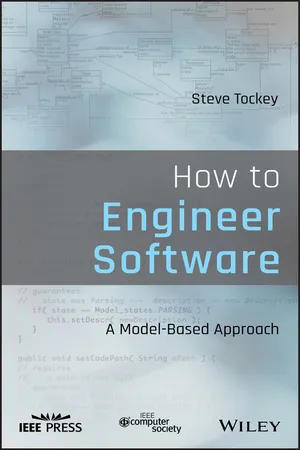
- English
- ePUB (mobile friendly)
- Available on iOS & Android
About this book
A guide to the application of the theory and practice of computing to develop and maintain software that economically solves real-world problem
How to Engineer Software is a practical, how-to guide that explores the concepts and techniques of model-based software engineering using the Unified Modeling Language. The author—a noted expert on the topic—demonstrates how software can be developed and maintained under a true engineering discipline. He describes the relevant software engineering practices that are grounded in Computer Science and Discrete Mathematics.
Model-based software engineering uses semantic modeling to reveal as many precise requirements as possible. This approach separates business complexities from technology complexities, and gives developers the most freedom in finding optimal designs and code. The book promotes development scalability through domain partitioning and subdomain partitioning. It also explores software documentation that specifically and intentionally adds value for development and maintenance. This important book:
- Contains many illustrative examples of model-based software engineering, from semantic model all the way to executable code
- Explains how to derive verification (acceptance) test cases from a semantic model
- Describes project estimation, along with alternative software development and maintenance processes
- Shows how to develop and maintain cost-effective software that solves real-world problems
Written for graduate and undergraduate students in software engineering and professionals in the field, How to Engineer Software offers an introduction to applying the theory of computing with practice and judgment in order to economically develop and maintain software.
Frequently asked questions
- Essential is ideal for learners and professionals who enjoy exploring a wide range of subjects. Access the Essential Library with 800,000+ trusted titles and best-sellers across business, personal growth, and the humanities. Includes unlimited reading time and Standard Read Aloud voice.
- Complete: Perfect for advanced learners and researchers needing full, unrestricted access. Unlock 1.4M+ books across hundreds of subjects, including academic and specialized titles. The Complete Plan also includes advanced features like Premium Read Aloud and Research Assistant.
Please note we cannot support devices running on iOS 13 and Android 7 or earlier. Learn more about using the app.
Information
Table of contents
- Cover
- Table of Contents
- Foreword
- Preface
- Acknowledgments
- Online Resources
- Part 1: Introduction and Foundations
- Part II: Semantic Modeling
- Part III: Model‐Based Design and Code
- Part IV: Related Topics
- Part V: Summary
- Part VI: Appendices
- References
- Index
- End User License Agreement